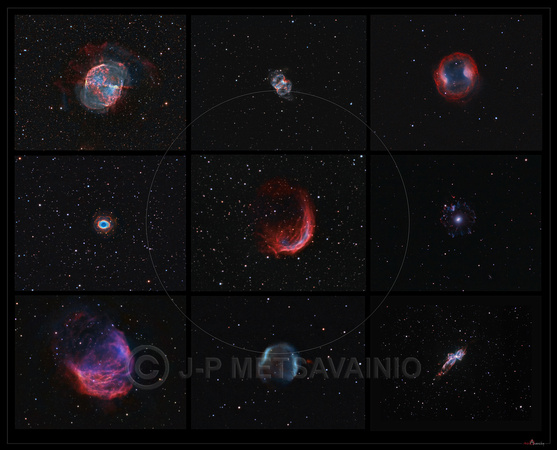A Planetary Nebula poster
A Gray circle marks the size of the full Moon. (~30' or 0,5 degrees)
I made this poster to show the relative sizes of the nebulae.
All Planetary Nebulae in this image are in same scale. Each individual image covers an area of 20' horizontally. (~0,3 degrees) and
they are in "natural" colors, mixed from the narrowband channels. By a following method:
Natural color composition from the emission of ionized elements, R=80%Hydrogen+20%Sulfur, G=100%Oxygen and B=85%Oxygen+15%Hydrogen to compensate otherwise missing H-beta emission. This composition is very close to a visual spectrum.
All of images are Planetary Nebulae.
Planetary nebulae are shells of gas, shed by stars late in their life cycles after using up all of their nuclear fuel. The gas is illuminated and ionized by its extremely hot central star, a core left from the original star.
Our own star, the Sun, is expected to undergo the same process in a couple of billion years.
Images, from top Left to a bottom Right
Large images and the technical data behind links
M27, the "Dumbbell Nebula":
http://astroanarchy.blogspot.com/2011/02/m27-dumbbell-nebula-reprocessed.html
M76, the "Little Dumbbell Nebula":
http://astroanarchy.blogspot.com/2010/11/m-76-little-dumbbell-nebula.html
PK 164+31.1, Jones-Emberson 1:
http://astroanarchy.blogspot.com/2010/02/planetary-nebula-pk-164311-finalized.html
M57, the "Ring Nebula":
http://astroanarchy.blogspot.com/2010/10/m57-ring-nebula-project-finalized.html
Sh2-188:
http://astroanarchy.blogspot.com/2010/11/sh2-188-project-finalized.html
NGC 6543, the "Cat's Eye Nebula":
http://astroanarchy.blogspot.com/2011/01/cats-eye-nebula-reprocessed.html
Sh2-274, the "Medusa Nebula":
http://astroanarchy.blogspot.com/2011/02/medusa-nebula-sh2-271-project-finalized.html
Jones 1:
http://astroanarchy.blogspot.com/2010/11/jones-1-extreme-dim-planetary-nebula.html
NGC 6302, the "Bug Nebula":
http://astroanarchy.blogspot.com/2010/07/ngc-6302-bug-nebula.html


